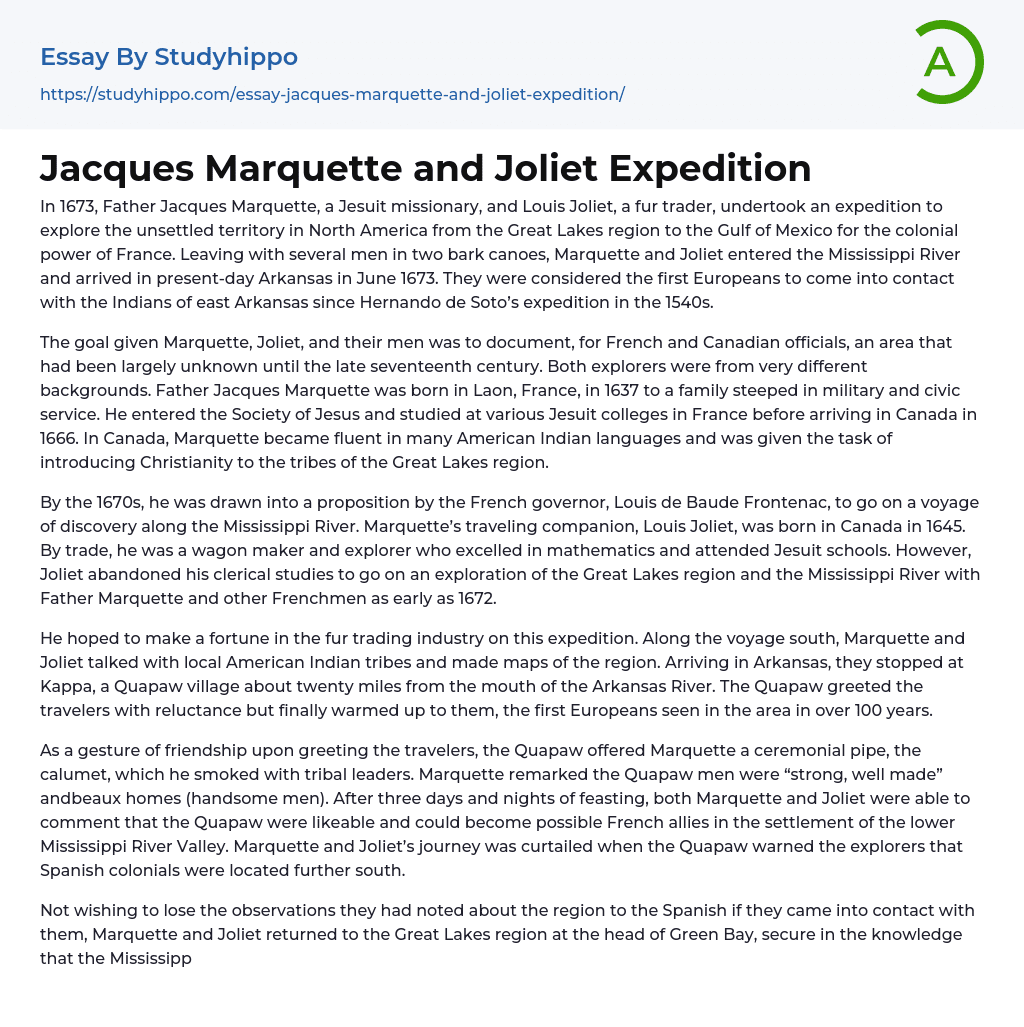In 1673, at the request of French colonial authorities, Jesuit missionary Father Jacques Marquette and fur trader Louis Joliet launched an expedition to investigate unexplored areas of North America. Their journey extended from the Great Lakes region down to the Gulf of Mexico. Using two bark canoes as their mode of transportation, they eventually arrived at the Mississippi River. By June 1673, they had reached what is currently known as Arkansas - a significant milestone that distinguished them as the first Europeans to make contact with native people in eastern Arkansas since Hernando de Soto's voyage in the 1540s.
The objective assigned to Marquette, Joliet, and their crew was to explore and record, for French and Canadian authorities, an area which until the late 17th century was majorly unknown. The two explorers hailed from distinct backgrou
...nds. Father Jacques Marquette born in 1637 in Laon, France, belonged to a family renowned for military and civic services. He joined the Society of Jesus and attended numerous Jesuit colleges in France before his arrival in Canada in 1666. In Canada, Marquette mastered several indigenous American languages and was entrusted with the mission of propagating Christianity among the tribes of the Great Lakes area.
In the 1670s, Louis de Baude Frontenac, the French governor at that time, enticed a journey of exploration down the Mississippi River. Accompanying on this expedition was Marquette's colleague, Louis Joliet, who was born in Canada in 1645. His career involved wagon making and adventuring; he had remarkable mathematical abilities acquired through his education at Jesuit schools. Despite this, Joliet abandoned his religious studies to participate in an expedition exploring the
Great Lakes region and the Mississippi River alongside Father Marquette and other French associates as early as 1672.
With aspirations of amassing wealth through the fur trade industry, he embarked on his expedition. As Marquette and Joliet journeyed further south, they engaged with native American Indian tribes, diligently charting the region. Upon reaching Arkansas, they made their stop at Kappa, a Quapaw village situated approximately twenty miles from the Arkansas River's mouth. Initially hesitant, the Quapaw people eventually grew warm towards the visitors — the first foreign faces they had seen in over a century.
As a welcoming act when they met the travelers, the Quapaw gifted Marquette a ceremonial pipe called the calumet, which he shared with the tribal chiefs. Marquette commented on the Quapaw men's strength and good looks, referring to them as beaux homes (handsome men). After spending three days and nights in feasting, both Marquette and Joliet found the Quapaw to be pleasant and potential allies of the French in colonizing the lower Mississippi River Valley. However, their journey was cut short when they were warned by the Quapaw about Spanish colonists settled further south.
Upon their return to the area of the Great Lakes, specifically the northern tip of Green Bay, Marquette and Joliet aimed to safeguard their critical findings about this region from potentially being accessed by the Spanish. They reaffirmed that Mississippi River indeed empties into the Gulf of Mexico based on information given by the Quapaw Indians in Arkansas. Before they left, a cross was erected in Kappa village by Marquette's team. The journey undertaken by Marquette and Joliet is significant as it realises
France's goal for a water route connecting between Great Lakes region and Gulf of Mexico.
The French authorities, drawing on accounts from Marquette, Joliet, and the Quapaw Indians of Arkansas, could start to establish forts along the river, create a buffer against the English colonies, and spread Catholicism. Moreover, the data obtained from the explorations paved the path for further French expeditions, including those by Rene-Robert Cavelier, Sieur de La Salle in 1682 and Henri de Tonti, who ventured to Arkansas and founded Arkansas Post (Arkansas County) in 1686 - being the initial European settlement to the west of the Mississippi River.
Not only did Marquette and Joliet identify the potential for establishing sturdy alliances with the indigenous peoples residing in the lower Mississippi River Valley, especially Arkansas, but they also exerted considerable effort to actualize this. Following their voyage, Father Marquette resumed his duties with the Kaskaskia tribe near present-day Utica at Starved Rock. Regrettably, he became sick and passed away on May 18, 1675, when he was thirty-nine years old. His remains were subsequently returned to Mackinac's Catholic mission, now known as Michigan.
Louis Joliet, a notable expeditionary partner, went back to Quebec where he got married. He was granted land ownership of Anticosti Island in Quebec and continued undertaking exploration missions within the area, including Labrador in eastern Canada. In 1680, he was named as the royal hydrographer - a role that encompassed the comprehensive research of numerous bodies of water like seas, lakes, and rivers, and was awarded the control of Joliet seignory (located south of Quebec) in 1697. Louis Joliet passed away in Canada in May
1700, with his gravesite remaining undisclosed.
- Travel essays
- Asia essays
- Caribbean essays
- Developing Country essays
- America essays
- City essays
- Africa essays
- Australia essays
- Europe essays
- Georgia essays
- Middle East essays
- New Zealand essays
- South Korea essays
- Thailand essays
- Afghanistan essays
- Dubai essays
- North Korea essays
- Natural Disaster essays
- Earthquake essays
- Fracking essays
- Mountains essays
- Restaurant essays
- Hospitality essays
- Business Travel essays
- Hotels essays
- Tourism essays
- World Tourism Organization essays
- Kids travel essays
- Travel Agency essays
- ecotourism essays
- Air Travel essays
- Sea Travel essays
- Cathedral essays
- Traveling essays
- Fast Food Restaurant essays
- Motel essays
- Cultural Tourism essays
- The real essays
- Airlines essays
- Airports essays
- Boeing essays
- Low-Cost Carrier essays
- Easyjet essays
- Bangladesh essays
- Kuala Lumpur essays
- Malaysia essays
- Manila essays
- Philippines essays
- Singapore essays
- Vietnam essays




